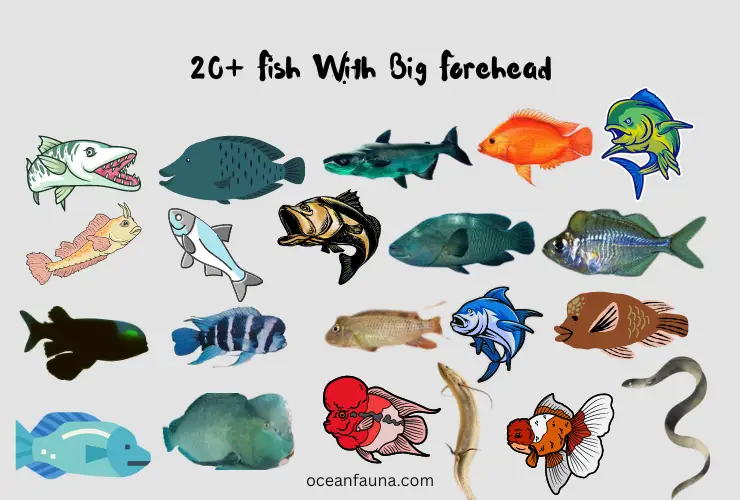The marine life is full of surprise and mystery. Sometimes the creatures of the deep can appear quite unusual- particularly compared to their terrestrial counterparts. For example, fish with big forehead.
The depths of the ocean house a vast array of species with oversized heads, many of which have yet to be discovered or popularized. Some are so remarkable that they’ve become renowned for their extraordinary size and shape.
In this article, I will discuss over 20 species of fish with remarkable forehead protrusions. For your convenience, I have outlined a table that contains information on these unique fishes. Here you can discover what makes them so fascinating.
| No. | Bighead Fish Names | Behavior |
| 1 | African lungfish | It can survive out of water for several years (up to 4 years) by burrowing in mud and producing a mucus cocoon. |
| 2 | Asian Sheepshead Wrasse | It is a hermaphroditic species that can change gender from female to male during its lifespan |
| 3 | Barreleye Fish | It has a transparent head, which allows it to see above and below at the same time. |
| 4 | Bighead carp | It can grow up to 100 lbs and consume around 5%-15 of its body weight daily. |
| 5 | Bumphead parrotfish | It has strong teeth that can crush and eat coral, helping to keep coral reefs healthy. |
| 6 | Flowerhorn fish | It is a hybrid fish created by crossbreeding several different cichlid species. |
| 7 | Front cichlid | It is a highly territorial fish that builds large nests to protect its young. |
| 8 | Giant moray eel | It has two sets of jaws – one (oral jaws) to capture prey and the other (pharyngeal jaws) to pull the prey down its throat. |
| 9 | Giant trevally | It is a fierce predator known to attack birds in flight and even sharks. |
| 10 | Green Humphead Parrotfish | It plays a crucial role in the coral reef ecosystem by eating algae and keeping the reef clean. |
| 11 | Hump-headed Blenny | It has a unique defense mechanism where it inflates its head to scare off predators. |
| 12 | Humphead Glassfish | It is a small and slightly transparent fish that is popular in the aquarium trade. |
| 13 | Humphead wrasse | It can grow up to 7 feet long and weigh over 420 pounds, making it one of the largest reef fish in the world. |
| 14 | Largemouth bass | It is a popular game fish that is known for its aggressive behavior when hunting prey. |
| 15 | Lionhead cichlid | It has a distinctive “mane” of raised scales around its head, giving it its lion-like appearance. |
| 16 | Mahi-Mahi | It is a fast-swimming fish prized for its firm, white meat and is popular in seafood cuisine. |
| 17 | Mekong giant catfish | It is one of the largest freshwater fish in the world, with some individuals growing up to 9-10 feet long and weighing up to 440 lbs. |
| 18 | Midas Cichlid | It is a highly aggressive fish known for its bright orange coloration. |
| 19 | Napoleon fish | It is a slow-growing, long-lived fish that can live for 30 – 50 years and grow up to 7.5 feet long. |
| 20 | Oranda | It is a fancy goldfish with a distinctive “wen” or head growth on top of its head. |
| 21 | Pacific barracuda | It is a fast-swimming predator that feeds on smaller fish and squid. |
20+ Fish With Big Forehead
Here are details of the 20+ big forehead fish.
African Lungfish
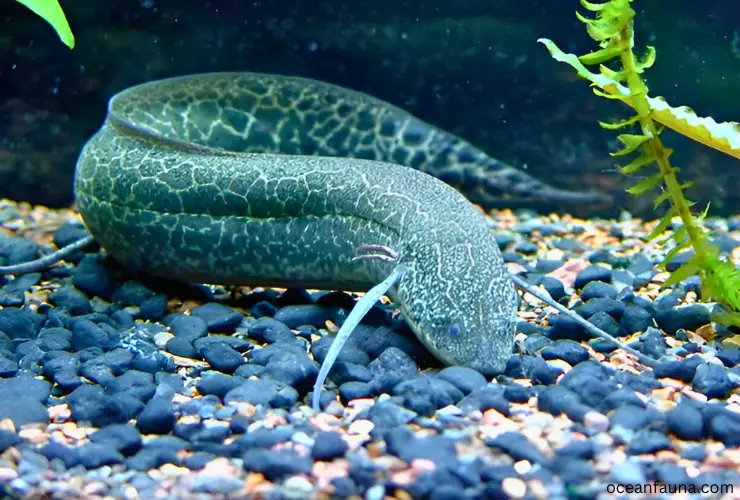
The Protopterus annectens, often known as the African lungfish, is a fish in the family Protopteridae, which is part of the order Lepidosireniformes. It is found in freshwater settings across Africa. It is an omnivore, eating anything from small fish and frogs to crustaceans, insect larvae,, and even tree roots.
The African lungfish has a long head, smooth body, dorsal fin, and anal fin. The head has organs that help it find its way when there isn’t much light.
The African lungfish has a unique reproductive mechanism where it can lay eggs or give birth to live offspring depending on the environmental conditions. The IUCN Red List classifies this species as “Least Concern” because of its long expected lifespan of 20 years or more.
Asian Sheepshead Wrasse
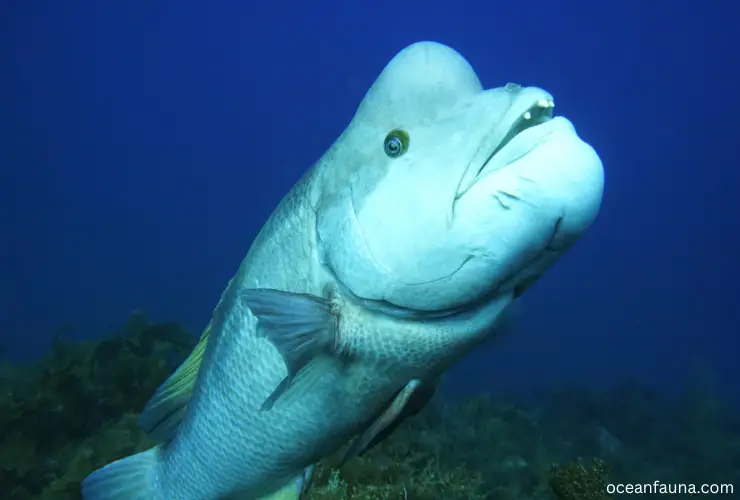
The Asian Sheepshead Wrasse, or Semicossyphus reticulatus, is a member of the family Labridae in the order Perciformes. It inhabits the coastal waters of the Western Pacific Ocean, including East Asia, mainly Japan and Korea. Sea plants, crustaceans, mollusks, and fish make up the bulk of its food.
Asian Sheepshead Wrasse has a big head with a forehead that sticks out, a long snout, and strong jaws that it uses to crush shellfish. The body is smooth, and the dorsal fins are sharp.
The Asian Sheepshead Wrasse is a slow-growing species, and males can reach a lifespan of up to 25 years, whereas females can live up to 30 years. It is currently classed as “Data Deficient” on the IUCN Red List.
Barreleye Fish
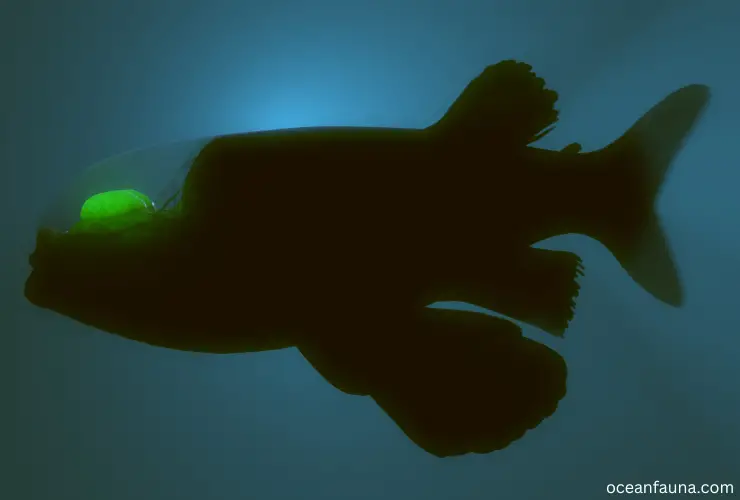
Barreleye Fish (Macropinna microstoma) is a species of fish in the family Opisthoproctidae, which is part of the order Osmeriformes. Specifically, the Monterey Bay Aquarium Research Institute has discovered it in the Pacific Ocean’s deep seas. It eats zooplankton, siphonophores, and crustaceans.
Barreleye fish has an extensive and transparent head. The body is covered in skin that looks like jelly. The Barreleye Fish can see both above and below because of its transparent head. Its lifespan is unknown, and it is not thought to be at risk of extinction.
Bighead Carp
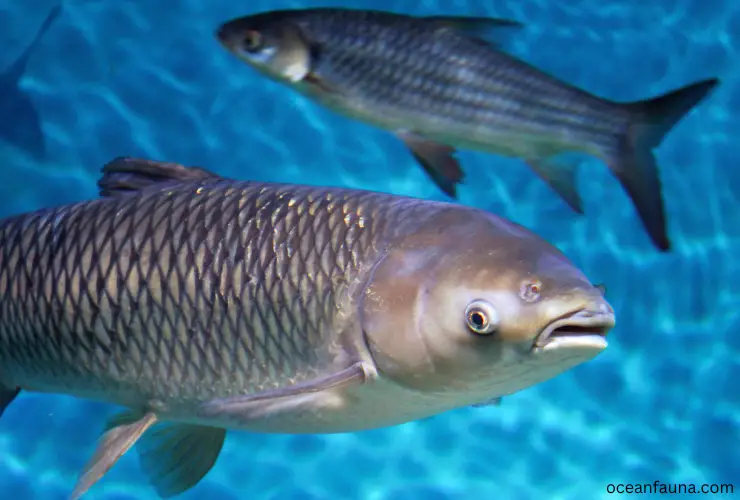
The bighead carp, or Aristichthys nobilis, is a member of the family Cyprinidae and the order Cypriniformes. It is native to China but has been brought to many other nations, including the United States. Its food consists of plankton and debris.
The body of a bighead carp is long and thin, and its fins are set far back on the body. The mouth is enormous and is used to feed with a filter.
The Bighead carp can live for up to 16 years, and it is banned or heavily controlled in many countries due to its invasive nature.
Bumphead Parrotfish
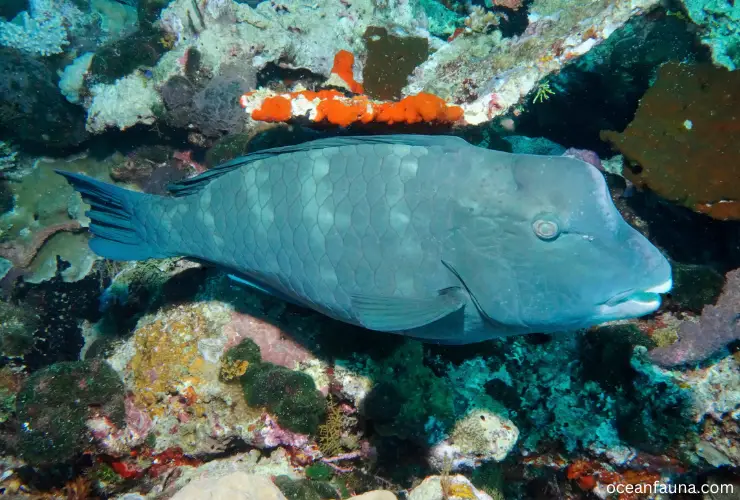
The bumphead parrotfish, or Bolbometopon muricatum, is a member of the family Scaridae, which is part of the Perciformes order of fish. It inhabits the Indo-Pacific region, specifically the coral reefs of the Indian and Pacific oceans.
The bumphead parrotfish has a big head with a bump on top, strong jaws, and sharp teeth that it uses to eat coral. The body is brightly colored, and the tail is long and pointy.
It uses its strong beak to eat hard coral, which it then digests. They can live up to 40 years. The IUCN Red List classifies the Bumphead parrotfish as “Least Concern.”
Flowerhorn Fish
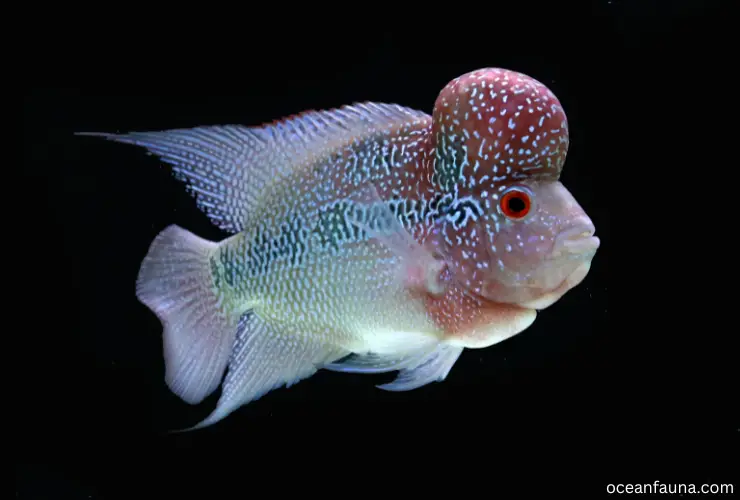
The flowerhorn fish (Cichlasoma trimaculatum x Amphilophus labiatus) is a hybrid fish that is not seen in the wild. Its vibrant colors and oddly shaped head have made it a favorite aquarium fish.
The front cichlid has a big head, a forehead that slopes down, a long body, and sharp fins. The mouth is enormous, and the teeth are sharp.
Live food like worms, shrimp, and pellets make up its diet. There is no reason to worry about the extinction of Flowerhorn fish, which can live up to 10-12 years.
Front Cichlid
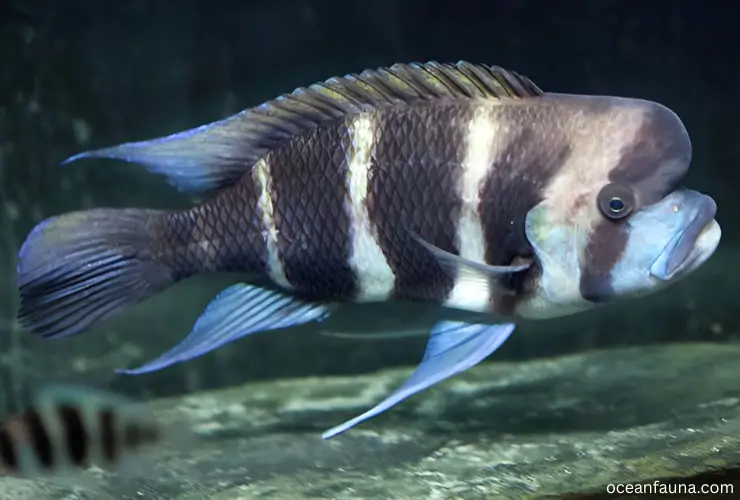
The front cichlid (Cichlasoma frontosa) is a member of the family Cichlidae and the order Perciformes. It is found in the freshwater of Lake Tanganyika in East Africa. It eats crustaceans, insects, blood worms, krills, and smaller fish.
The front cichlid has a big head, a forehead that slopes down, a long body, and sharp fins. The mouth is enormous, and the teeth are sharp.
They can live up to 25 years. This fish species is not in danger of going extinct, so they are listed as “Least concern.”
Giant Moray Eel
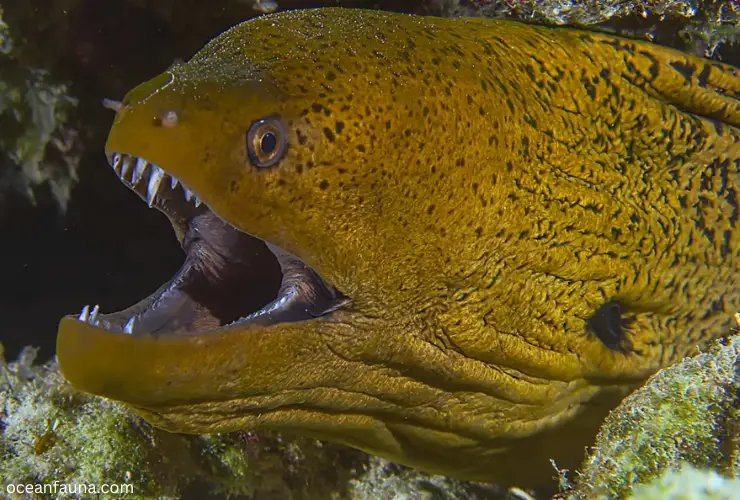
Gymnothorax javanicus, often known as the giant moray eel, is a member of the family Muraenidae in the order Anguilliformes. The tropical waters of the Indo-Pacific are home to this animal.
The giant moray eel has a long body covered in slime and a big head. It has a wide mouth with sharp teeth and no dorsal fin.
Fish, crustaceans, and cephalopods make up the bulk of its food. They have a possible lifespan of 10-40 years. Also, the giant moray eel is unlikely to go extinct.
Giant Trevally
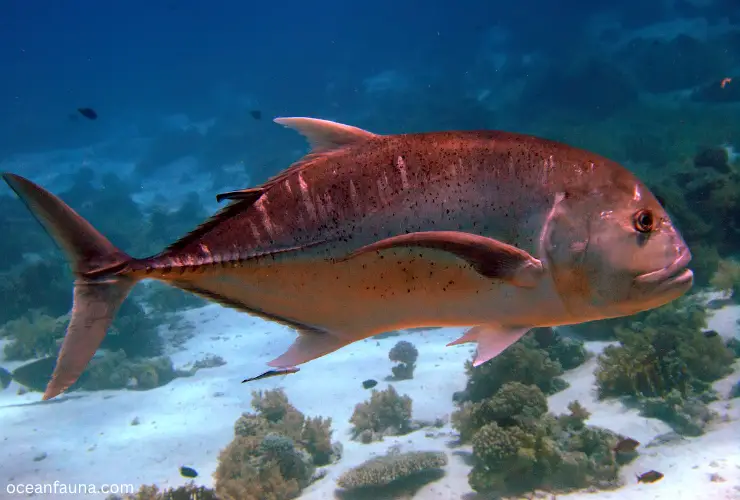
The giant trevally, or Caranx ignobilis, is a member of the family Carangidae in the order Perciformes. The tropical waters of the Indo-Pacific are home to this animal. It eats crustaceans, cephalopods, and tiny fish.
The giant trevally has a big head, a smooth body, and sharp fins. The mouth is wide, and the jaws and teeth are strong to help catch prey. They can live up to 24 years and are not in danger of going extinct soon.
Green Humphead Parrotfish
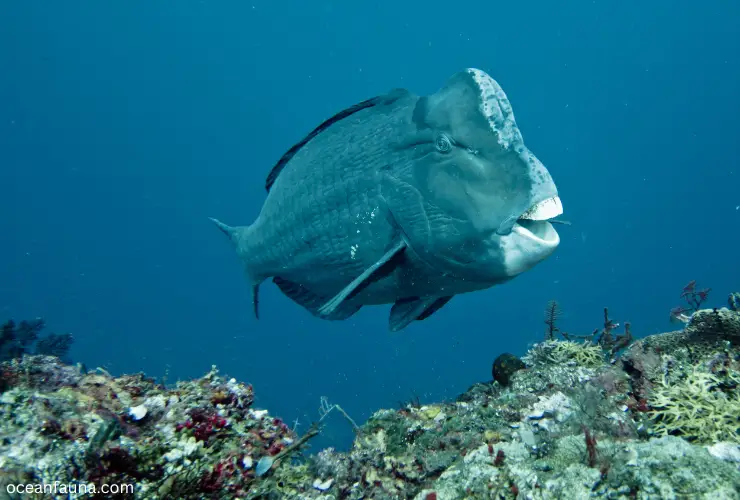
The green humphead parrotfish, Bolbometopon muricatum, is a member of the family Scaridae, which is part of the Perciformes order of fishes. It inhabits the waters of the Pacific and Indian Oceans. Its strong beak is adapted for the digestion of hard coral and benthic algae, the primary component of its food.
This fish has a big head with a bump on top, strong jaws, and thick lips that it uses to crush coral. The body is brightly colored, and the tail fin is sharp.
The Green Humphead Parrotfish can live up to 40 years but are listed as Vulnerable under ICUN red list due to their dwindling numbers.
Hump-Headed Blenny
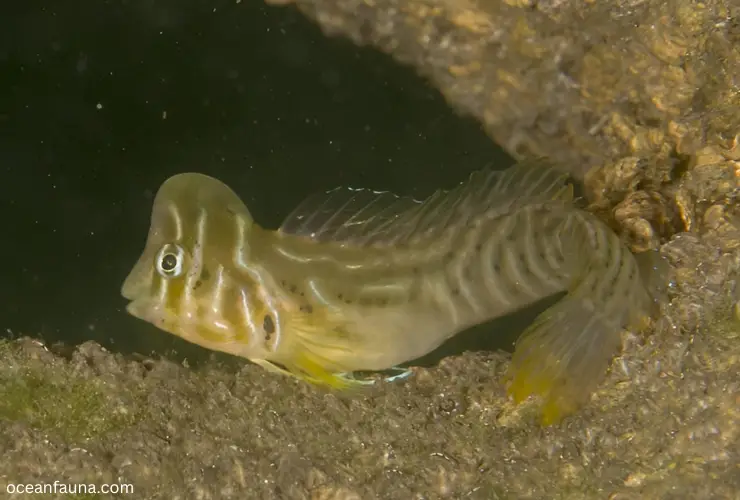
The hump-headed blenny (Acanthemblemaria spinosa) is a member of the family Chaenopsidae, which is part of the Perciformes order. It inhabits the Caribbean Sea and, more specifically, its coral reefs.
It has a big head with a bump on the top of its head. Its jaws are strong, and it has sharp teeth for eating invertebrates. Small scales cover the body, which can have green, red, yellow, and blue highlights.
Its food comprises tiny invertebrates. The Hump-headed Blenny is not in danger of going extinct any time soon.
Humphead Glassfish
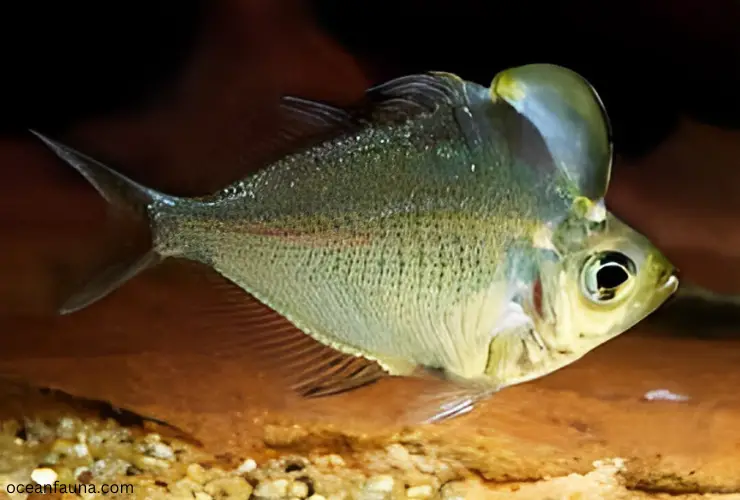
The humphead glassfish (Parambassis pulcinella) is a member of the family Ambassidae of the order Perciformes. It inhabits Southeast Asian freshwater ecosystems. It eats crustaceans and smaller fish.
A humphead glassfish has a small head with a big bump on the forehead, and its eyes are big so it can see its prey. A clear coat with yellow and purple highlights covers the body.
The conservation status of this fish is under the “Data Deficient” list. Also, this fish can live ranging between 3-8 years.
Humphead Wrasse
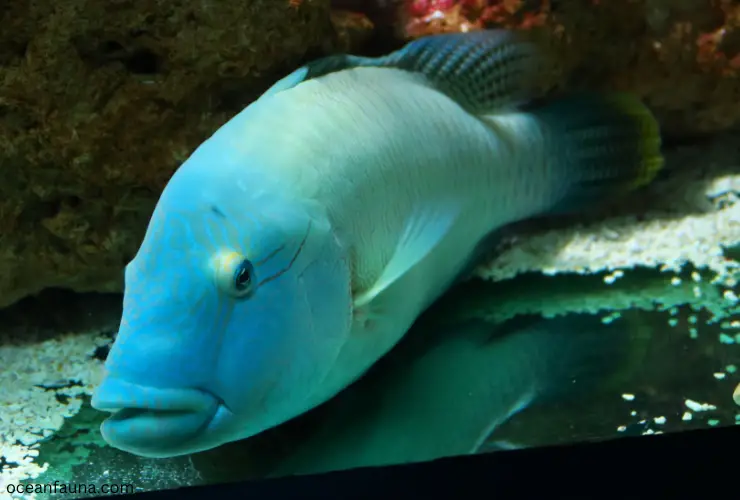
The humphead wrasse (Cheilinus undulatus) is a member of the family Labridae and the order Perciformes. It inhabits the coral reefs in the Indian and Pacific Seas. Its powerful teeth are adapted for crushing the tough coral that makes up its meal.
This fish has a big head with a prominent hump on its forehead. It also has big eyes and strong jaws that help it tear apart its prey. The body is covered with scales of different colors, including red, yellow, and blue.
The humphead wrasse can live up to 30 years and is considered Endangered by the International Union for the Conservation of Nature.
Largemouth Bass
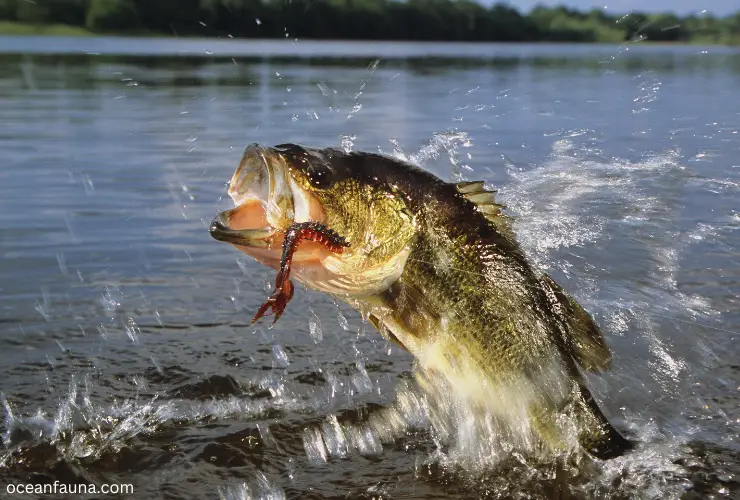
The largemouth bass (Micropterus salmoides) is a member of the family Centrarchidae and the order Perciformes. It inhabits freshwater ecosystems all over the continent. It eats crustaceans, insects, and smaller fish.
It has a big head, a forehead that slopes down, and big eyes that help it find food. It has scales all over its body, with green, brown, and black spots.
The largemouth bass has a lifespan of up to 16 years and is considered as “Least Concern” in the res list of ICUN.
Lionhead Cichlid
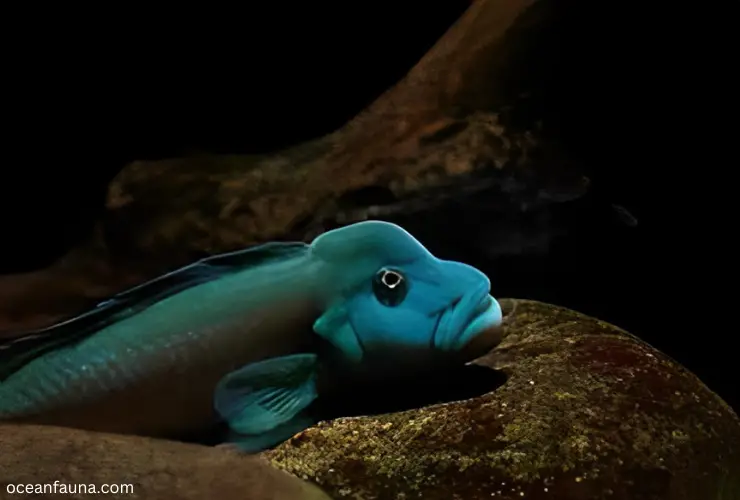
The lionhead cichlid (Cichlasoma)is an artificially created hybrid. Its distinctive snout makes it a sought-after addition to home aquariums. Live food like small crustaceans, worms, shrimp, pellets, plants, algae, and plankton make up its diet.
Lionhead Cichlids have a small head with a big bump on the forehead. They also have big eyes that help them find food and bright colors with red and yellow highlights. They are not in danger of extinction and can live for up to -8 years.
Mahimahi
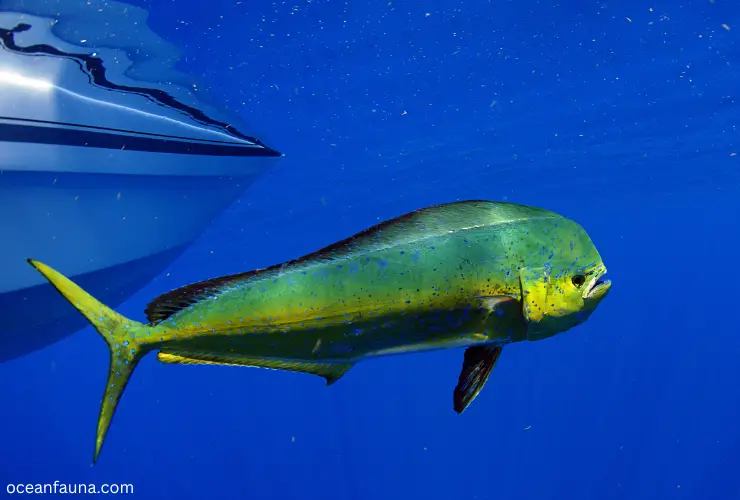
The mahimahi, or Coryphaena hippurus, is a member of the family Coryphaenidae of the order Perciformes. It inhabits the warm seas of the Atlantic, Pacific, and Indian oceans and their subtropical regions.
Mahimahi has a long body and a long, cylindrical snout with big eyes. It has a mix of blue and green colors, with yellow accents along the sides.
It eats crustaceans like squid, tuna, billfish, pompano and smaller pelagic fish, and so on. There is no reason to worry about the extinction of mahimahi, which can live up to 3-4 years.
Mekong Gigantic Catfish
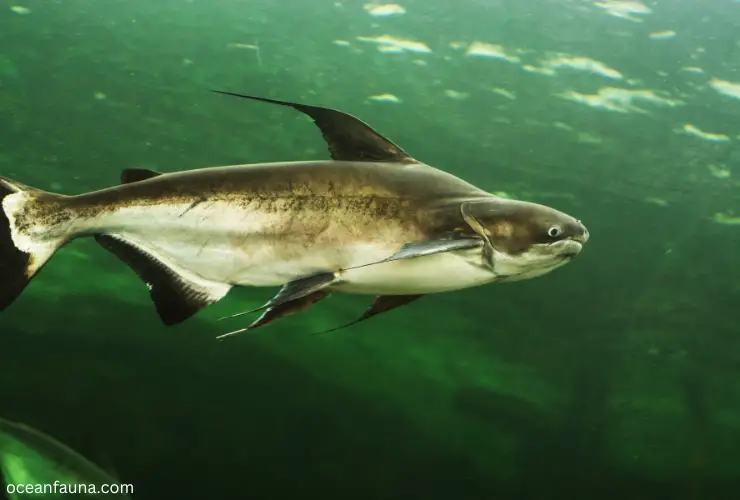
The Mekong gigantic catfish (Pangasianodon gigas) is a member of the family Pangasiidae and the order Siluriformes. It inhabits the region around the Mekong River in Southeast Asia. The babies are cannibalistic and consume zooplankton.
The Mekong giant catfish has a long body, a big head, and a lower jaw that sticks out. It is a gray, white, and black mix with black accents along the sides.
As they grow, they become herbivores and eats plants and algae. The Mekong gigantic catfish, which can live up to 60 years, is critically endangered, according to the International Union for Conservation of Nature (IUCN) Red List.
Midas Cichlid
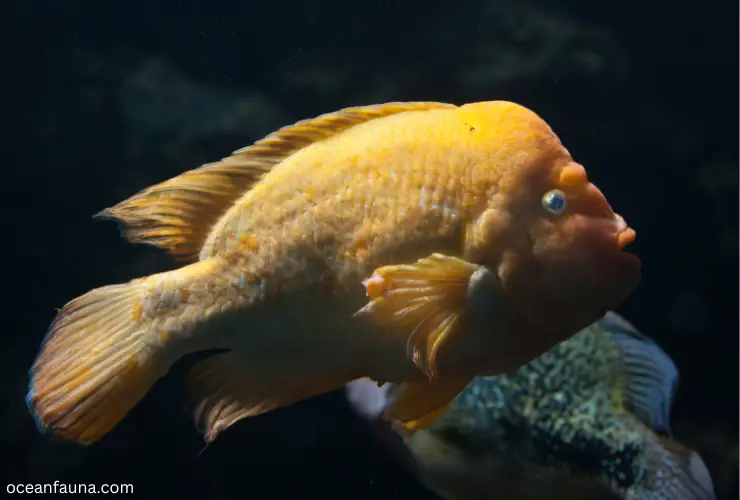
The Midas Cichlid, or Amphilophus citrinellus, is a member of the family Cichlidae and the order Perciformes. It inhabits Central America’s freshwater ecosystems. Not only do they feed on snails, but these creatures also consume a variety of benthic matter, such as aquatic insects, minuscule fish, and an assortment of plant and animal material.
The Midas Cichlid has a big head, mouth, and eyes. It has a mix of yellow and orange colors all over it, with dark spots on the sides.
They can live up to 10-12 years. Also, they are listed as “Least concern” under ICUN red list, so there is less risk of extinction.
Napoleon Fish
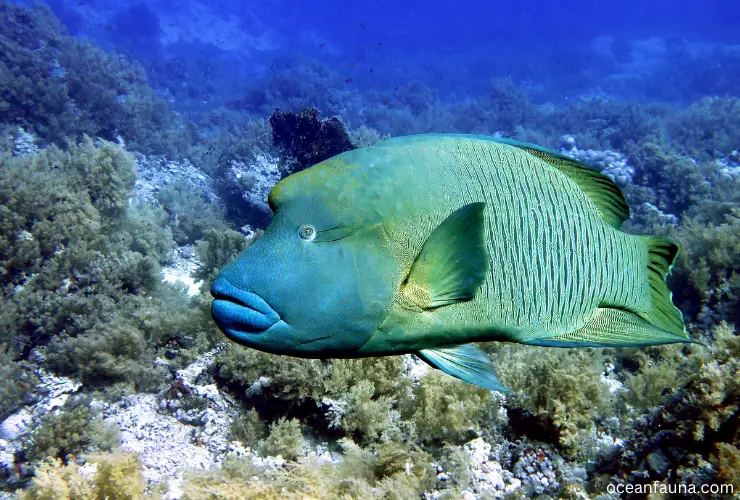
The Napoleon fish (Cheilinus undulatus) is a member of the family Labridae, which is part of the order Perciformes. It inhabits the coral reefs in the Indian and Pacific Seas. These predatory fish prey on shellfish, other species of fish, sea stars, sea urchins, and crabs – crushing their shells to access the animal inside.
Napoleon Fish have long bodies, big heads, and large eyes. It has a mix of blue and green colors, with yellow accents along the sides. Their lifespan is up to 50 years. The IUCN Red List has designated the Napoleon fish as Endangered.
Oranda
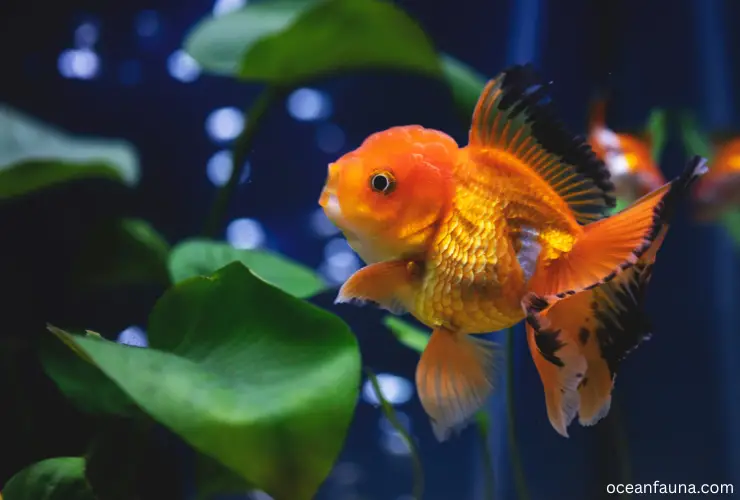
The oranda (Carassius auratus) is a member of the family Cyprinidae and the order Cypriniformes. It is a popular aquarium fish and is recognized for its distinctive head growth. They are omnivores.
Oranda has a short body, a big head, and a forehead that sticks out a lot. It is covered in shades of orange, red, and yellow, with black accents along the sides.
Live food like worms, shrimp, pellets, plankton, and algae make up its diet. The oranda can live up to 15 years and is not in danger of going extinct.
Pacific Barracuda
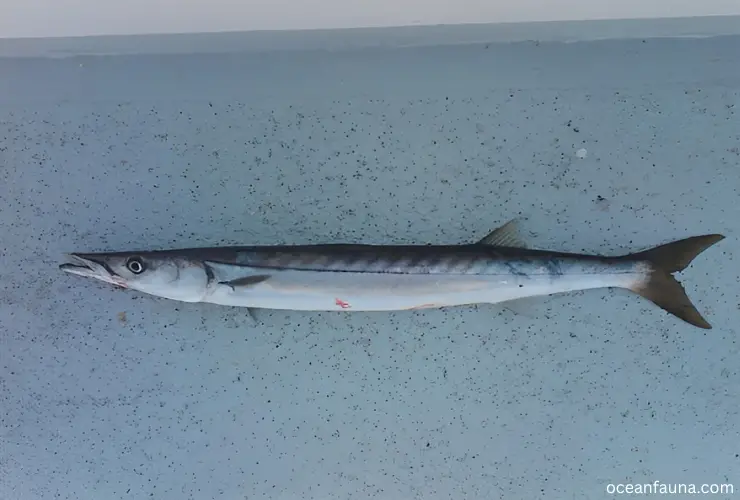
The Sphyraena argentea, often known as the Pacific barracuda, is a member of the perciformes family. Specifically, off the coasts of California and Mexico, it inhabits the coastal waters of the eastern Pacific Ocean.
The body of the Pacific Barracuda is long and thin, and its eyes and head are big. It has a mix of silver, blue, and green colors, with black accents along the sides.
It eats crustaceans like squid and smaller fish. With a potential lifespan of over 14 years, the Pacific barracuda is unlikely to go extinct.
Conclusion
Hopefully, you get to learn something new from this article. I have discussed here 21 fish with big foreheads. However, numerous other aquatic creatures have developed this adaptation as well in order to survive effectively within their environment.
A bigger forehead may provide various benefits such as predator protection or the ability to create suction while feeding. Whatever the reason, it’s really fascinating how nature has empowered some of these fishes with such incredible adaptations.

